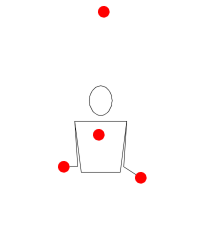Siteswap: The Math of Juggling
Okay, this one is going to be pretty controversial. Because nobody likes math, but everyone loves juggling (😨right?). But it’s a really interesting topic, and learning the basics of siteswap means you’ll understand the patterns behind juggling better than the rest of the non-juggling world (and a lot of jugglers too tbh).
So let’s learn!
Juggling can seem really chaotic, but when its patterns are broken down, it’s actually very controlled and organized. If it weren’t, it would be really tough to keep more than a couple balls in the air for very long. And since juggling is a phenomenon of movement, siteswap notation was developed to describe the juggling patterns using numbers.
In siteswap notation, the height of each throw is represented by a number. Also, because juggling is a pattern, every siteswap can be repeated infinitely. So in the “531” pattern, one ball is thrown at a height of 5, the next a little lower at 3, and the third ball is thrown even lower at a height of 1. Then, that pattern is repeated. This illustration from Wikipedia makes it easier to see the relative height differences between these numbers.
The most basic siteswap is “3.” It means every ball is thrown at a height of 3. A height of 3 is not a specified length; it’s just relative to other throws. The actual height of the throw varies depending on the juggler and how he/she is juggling, but a 3 is always lower than a 5 and higher than a 1. In the “3” pattern below (a basic 3 ball juggle), every ball is thrown at the same height and crosses hands. If you compare this to “5,” you’ll see that the balls are thrown relatively higher and therefore take longer to fall back to the hands.
(If these gifs aren't moving for you, you may need to open this blog in a different browser)
“3”
“5”
As you can see, higher numbers are higher throws, which means a longer beat (a time unit that is relative to the type of throw). Another interesting note is that odd numbers always cross hands, while even numbers are always thrown to the same hand. So for a basic pattern, when you see someone juggling an even number of objects, he/she is actually juggling half of those objects in one hand and half in the other; the objects never actually switch hands, even though they may appear to at first.
“4”
Obviously these are all very basic siteswaps; here are a few that a little more complex.
“534”
“53”
“97531”
Siteswap notation can be a really powerful tool for helping jugglers describe, learn, and understand juggling patterns. It’s also a great way to illustrate how ordered and scientific juggling is, even though it seems so chaotic. So thanks for taking a little time to learn more about my favorite thing; I hope learning about siteswap makes juggling just that much more interesting to you!













